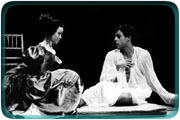November 2–9, 2000
theater
Beauty Isn’t Everything
 |
|
|
Things of beauty: Marcy Harriell as Nell Gwynn and Brandon Demery as Edward Kynaston. |
|
Compleat Female Stage Beauty
Philadelphia Theatre Co. at Plays & Players, 1714 Delancey St., through Nov.19, 215-735-0631
The granddaddy of drag queens, Edward Kynaston was the most famous — and the last — of the male actors playing female roles in 17th century England. His Desdemona caused Samuel Pepys — the play’s narrator — to write in his famous diary that Kynaston was "the most beautiful woman in the house." Playwright Jeffrey Hatcher (Three Viewings) has made a drama out of a historical footnote, creating a play about theater’s favorite subject: the theater. Although Hatcher takes liberties with history, it is fascinating material and the play offers plums for actors. It might be a delectable and important evening in the theater if it were a wittier play performed by better actors. As it is, it seems merely a slightly sour caprice.
When Charles II was restored to the throne of England (thus the era is called the Restoration) in 1660, he reopened the theaters. (Cromwell’s Puritans had closed them all in 1642 to prevent wickedness.) After 18 years of darkness and silence, there were new stages built, new plays written and new audiences eager for entertainment. Soon after, the King proclaimed that women were permitted to act upon the stage, and later, that men were forbidden to play female roles. Kynaston, the star of London, was suddenly out of work. So, according to Hatcher, he did what every unemployed actor does, he became a waiter. Finally, he hit rock bottom and joined a porn burlesque show; he is rescued and returned to his true calling as an actor (and briefly as a drama coach who seems to have invented naturalistic acting two centuries before the fact).
There are lots of philosophic jokes about homosexual men playing women who are in disguise as men, but whenever Compleat Female Stage Beauty approaches Tootsie territory, it loses its way and fails to make any intelligent point about gender, falling into easy sexual cliches. Nor does the play ever get anywhere near the brilliant device of Kiss Me Kate where the frame play echoes the Shakespearean play it contains. Hatcher also fails to develop the immense theatrical potential of showing an audience how theater works its magic on us while it’s working its magic on us.
The play begins with the last scenes of Othello; a white actor in blackface plays the Moor and a male actor in a gown and blonde wig plays Desdemona. First time around, it’s a hoot. The problem is that we don’t for a minute imagine that this scene is great tragedy. This same scene will be reprised many times during the evening by many actors — on stage, off stage, rehearsing, reversing roles, overacting, underacting, etc., etc. Everything sets us up for some dazzling finale when we will finally see the scene performed splendidly, when Shakespeare’s words will thrill us with their power and we will suddenly be swept up by great acting. But this never happens and all that is finally accomplished is that the real actors acting seem second rate — especially painful in a show about acting.
Brandon Demery is Edward Kynaston — handsome and charming, but with no depth either as himself, or as Desdemona or as Othello. Lauren Ward as the seamstress-turned-actress is moving, and the glimpse we get of her unaffected Desdemona is the best of the bunch. As Nell Gwynn, Marcy Harriell is adorable, and Jenny Bacon as Margaret Hughes (the first Restoration actress whose overacting is hilarious) is not much better than her role.
Director Walter Bobbie (who won the Tony for his direction of Chicago) keeps the pace lively, and the decision to use the bare boards of a stage as the set (created by John Lee Beatty, the Broadway designer) works nicely.






